Here's a typical sight in the city of St. Louis, MO, a gate to a private street. Runaway growth and an acute local sense of property rights drove St. Louis' 19th century elite into restricted residential enclaves, places where soap factories, locomotive works, dry goods emporiums, tanneries, etc., wouldn't appear overnight next door. Lucas Place, opened in 1851, was the city's first private street. By the beginning of the 20th century, there were 57 of them.
Like everything (and everybody) St. Louis has had its ups and downs. The 19th century, however, would seem to have been all up. The population, about 20,000 in 1840, leaped to 160,000 by 1860, then to 350,000 by 1880. By the beginning of the 20th century St. Louis was America's 4th largest city and proud host of the Louisiana Purchase Exposition of 1904. Things topped out in 1950, when 857,000 souls lived within the city limits. Postwar de-industrialization, suburban flight and urban decay - a term often synonymous with urban renewal - reduced that figure to 318,000 today.
Many of the city's private places succumbed along the way, but many survived to flourish again in today's environment of enlightened urban redevelopment - known less neutrally as gentrification. The grandest of them all is a pair of streets called Portland Place and Westmoreland Place that border Forest Park in the Central West End. Portland and Westmoreland are, true to the local paradigm, barred to through traffic, their intersections with the outside world ornamented by the gates in these photos.
How could I have never heard of these places? Me, of all people? Portland-Westmoreland, according to Julius K. Hunter who wrote a book on the subject, is a "scene of cumulative magnificence seldom if ever matched." And you know what? He's right.
Blocked by the Mississippi River on the east, 19th century St. Louis expanded westward, urbanizing the countryside with a rapaciousness bereft of aesthetic conscience or any kind of zoning. The development of Forest Park, opened in 1876, was to some extent a reaction to this. The park became a marker of the city's newest fashionable district.
The land beneath Portland and Westmoreland is located in what was called the Forest Park Addition. Why it's called this is a mystery to me, since as far as I can tell it was never intended to be part of the park. In 1887, it was bought by a group of speculators, who flipped it the following year to another group, who divided it in two. Portland and Westmoreland are often referred to as a unit, however, they are separate associations. The Westmoreland Place Assn. abuts and includes a row of spectacular houses facing Forest Park on a public road called Lindell Blvd. Unlike the houses in these images, they do not lie within the gated section of the association, and for that reason I have not included them here.
Author Charles Savage, in his "Architecture of the Private Streets of St. Louis" describes Portland-Westmoreland as the "apogee of architectural variety." He's right too. Concerning the architects who designed these places, east coast me recognized Shepley, Rutan & Coolidge and Peabody & Stearns, but few others. James Jamieson, W. Albert Swasey, Eames & Young, Theodore Link, Weber & Groves, Gale Henderson, etc., etc. unfortunately didn't ring bells. Assigning architectural labels is a slippery business, but to my eye the houses on these remarkable streets fall into 5 categories, to wit: Romanesque, Renaissance, Georgian, Classical and (OK, no other name for it) Eclectic. The first house within the gates went up in 1891, a time when residential fashion was heavily influenced by the Richardsonian Romanesque.
I have a penchant for grandeur, of which there's plenty in the Renaissance contingent. There are 87 houses on these two streets. Trying to identify the owners, dates and architects for every one of them is beside the point. Like Newport's Bellevue Avenue or New York's Tuxedo Park, Portland-Westmoreland's aesthetic strength lies as much in the impact of the ensemble as in the virtues of its individual houses.
Among other things, deed restrictions on original lot owners required them to spend at least $7000 on construction.
Some (but not all) of the Georgian and Georgian-influenced designs replaced earlier houses.
If it's got columns, we're calling it Classical.
And if it's a chateau or a Puritan manor, a mid-century modern (only one of those) or something Flemish, Mussolini Greek Revival or vaguely Prairie style, or I don't know what it is, then we're calling it Eclectic
If God is in the details (which is where He's supposed to be), then architectural charm will reside there as well - in stone lions and front doors, driveways and iron railings, and the cartouche over a front door with the initials of the person who built the house.
I did see a few interiors, which were predictably luxe, although not strong on vintage kitchens or baths.
I liked St. Louis and hope to visit again.













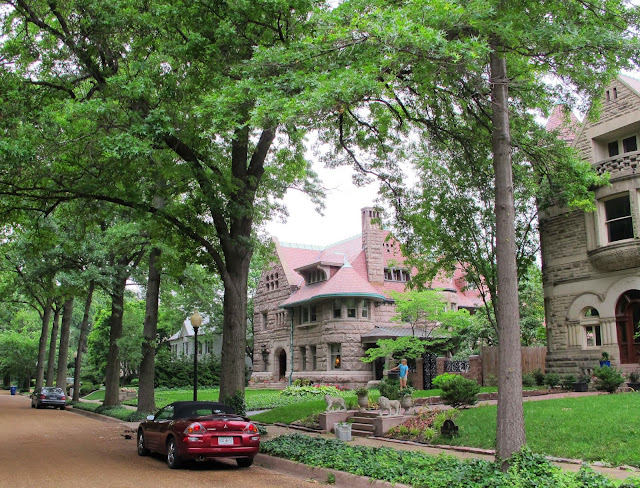






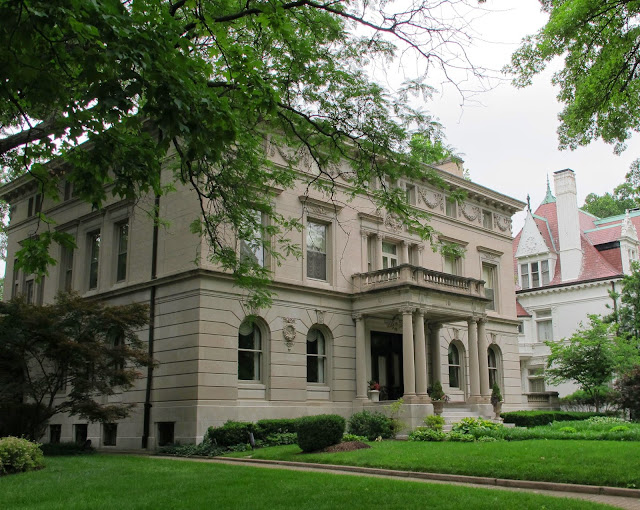















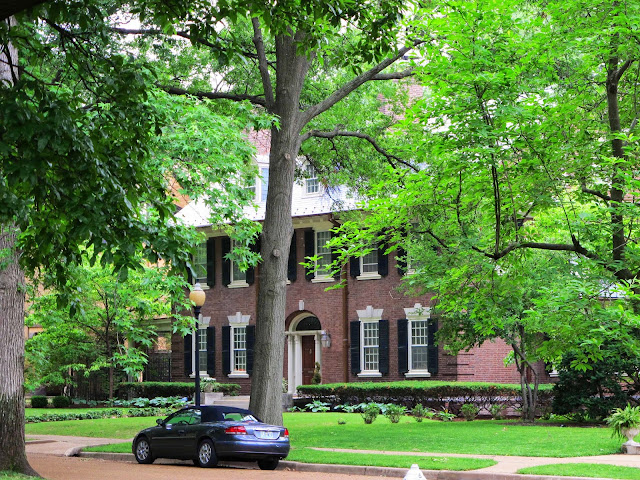



















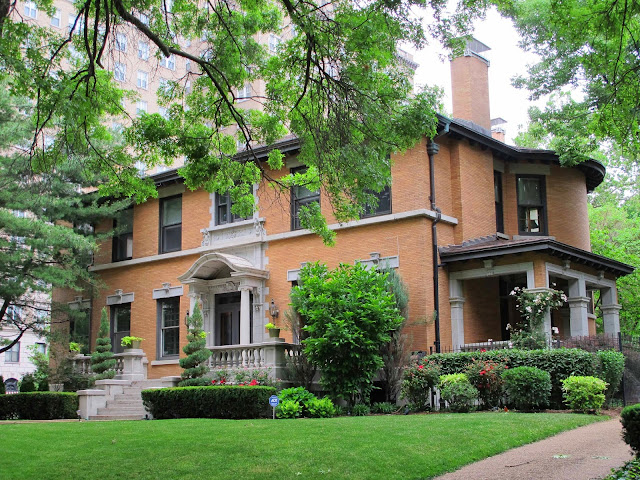







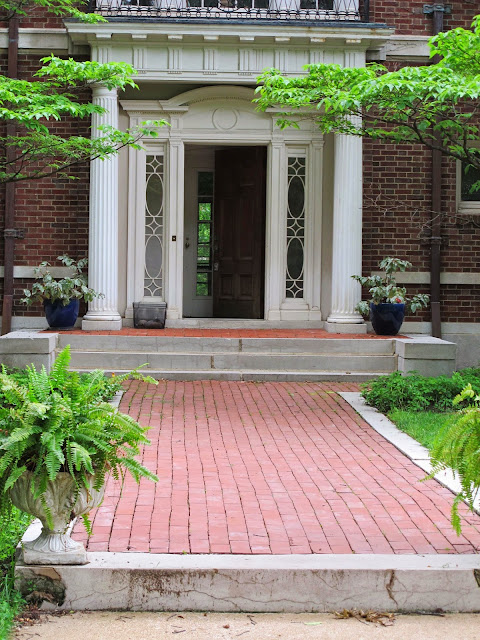
















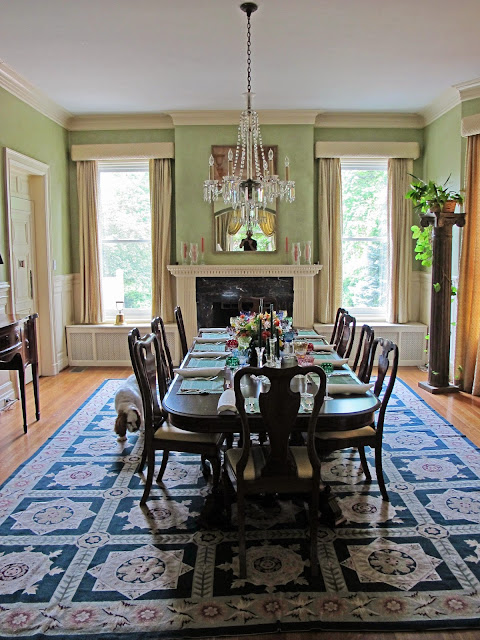




The photos of the architectural details are wonderful. It makes me sad that we don't have the will or ability to create things like that anymore.
ReplyDeleteBut we do, we do! Many architects possess the skills and an increasingly sophisticated cadre of builders exists who are able to implement our designs. If only there were clients both rich enough to afford and able to appreciate the value of quality work! So many new, large houses are hideous in the extreme, displaying very little obvious justification for the enormous sums spent on them.
DeleteI agree with Anon, Steve. There are fantastic architects out there and some new homes that are beautiful, creative, and well built, rather than a canned version of what "opulence" means. You would be right to say that variety and concentration of style and quality and extravagance will likely never be seens again. Maybe if you go to Dubai...
DeleteAs general contractors, we have had the pleasure of work on a couple of these houses. Our design perpective was to restore with modern conveniences. If you would like a peak at one of the kitchens, look under the custom cabinet tab, CWE 5 room kitchen restoration on our website www.ecostructionstl.com. Custom cabinets made by Missouri artisans in walnut and painted finishes.
Delete"Imposing" is the over-all word that I'd use. I've done some scattered reading over the years about St. Louis and its architecture (I've never been there) and it does appear some of the tasteful, scaled-down Georgian mansions replaced more flamboyant turn-of-the-century houses that a later generation didn't care to maintain. Or they just wanted something more up-to-date.
ReplyDeleteThank you for the great photographs! How well some vintage automobiles (say a Pierce Arrow here, a Packard there) would look in those driveways!
Wow Wow Wow Meet me in St. Louis! I want to live THERE!
ReplyDeleteI have lived there and, trust me, this is not representative of the properties in St. Louis. Most in the city are old like these but in various stages of repair and most are considerably more modest. I moved out of the city years ago because of the crime.
DeleteI have lived within 2 hours of St Louis my whole life, and was thrilled to see this post. There are still so many beautiful old mansions there, ranging from early/mid 19th century row house, throughtout the gilded age, all the way up to the "revival" houses built in the 1920s. What is not so beautiful is the pace with which St Louis is still destroying these old homes. Only a year or so ago, I saw a massive stone mansion near the hospital district (mid-town) being knocked down to make way for (you guessed it) another charming parking lot. I am glad that these two private streets are protected, hopefully these homes will continue to stand for years to come. Thanks as always for a wonderful posting!
ReplyDeleteDiscovered these streets a few decades ago and they never cease to amaze me. I want to live there. It is however sad to know that many a great city once had such streets, Euclid Ave comes to mind, where everyone who was anyone built spectacular mansions, but those streets have been ravaged by decay, city expansion, urban renewal and changing tastes and times to mention but a few reasons there are not more today. Why cant we build anything today that will stand the test of time like this neighborhood does? Instead we build cheap and fast with vinyl, plastics, faux stone and insulated styrene panels?
ReplyDeleteMy favorite aspect of these old homes are the glass and gated front doors. They're kind of peek-a-boo and teasing. They give you a tiny look inside and appear to be inviting, when in fact you're barred from entry.
ReplyDeleteSplendid!! I applaud you for recognizing architectural treasures in houses of the Midwest. Cincinnati doesn't have private streets, but there are areas that have outstanding residential architecture that you, and your readers, would appreciate. Thank you!!
ReplyDeleteA wonderful post about a pair of streets I have often visited. I lived in Illinois for many years and having friends on Portland Place I visited frequently. I've been inside many of the homes and the interiors match the exteriors...spectacular!
ReplyDeleteIt's not my intent to cause controversy, but I can't help but to think back to last week's post on the Magic Chef house. In the comments to the post somebody wrote about third floor ballrooms pointing out their inferiority to those on the more "proper" first floor. Not so... Third floor ballrooms were quite common in the mid-west and were considered proper rooms for entertaining. While certainly not the first such room one only has to look at H.H. Richardson's house for Franklin McVeigh in Chicago with it's magnificent French Renaissance third floor ballroom to the Charles Gates mansion in Minneapolis with it's massive (40' X 80' along with loggias) third floor ballroom in a pared down Italian style of the 1920's. I only bring this up now because many of the homes pictured in this post feature third floor ballrooms. I have been in five of them, I know of at least seven. They are spectacular - parquet floors, paneled walls, chandeliers, and stages for musicians. These rooms were not intended to train adolescents for future social successes, they were for the pleasure of the adults. In many cases the third floor ballrooms of the mid-west far surpass in both form and function those on the first floor of the east.
John, another great post and one that brings back many fond memories.
Wow what a street! I see 40 Portland Pl on the market for 1.75, 6 bedrms, 8 baths, great butlers pantry. Good pictures.
ReplyDeleteAs you pencil in your travel destinations for the months to come, John, please consider revisiting Portland-Westmoreland at Christmas! If you did nothing more than show us how the front doors were decorated...
ReplyDeleteA great post to use when selecting the style of one's new home. This is magnificent. Thank you, John, for treating us to your knowledge and good taste! You are a gift to your followers.
ReplyDeleteMike G, NYC
I love these Central West End houses, and am glad you have seen fit to post them. I've long wondered about private streets. St. Louis and St. Louis County are just full of them, sometimes with metal "sawhorses" placed in the roadway to slow traffic (in the suburbs, anyway). Often, the streets are left to deteriorate, all the better to calm traffic. They built private drives into the 1960s at least. In less affluent areas, the neighborhood residents have tried to give the streets to the city, to avoid upkeep expenses. But, overall, I like the rusticity and slow, almost non-existent traffic the streets allow.
ReplyDeleteI thought I had seen many of the great neighborhoods of midwestern cities where the grand single family residences prior to WWI where built...but this really outdoes all ... had no idea this existed all in one neighborhood, thank you!
ReplyDeletePut horses and buggies in the place of those modern cars and you have yourself a time warp. I just moved back to St. Louis after 25 years away and I couldn't be happier.
ReplyDeleteAs impressive as Portland and Westmoreland Places are, they pale in comparison to Vandeventer Place, which was build about 10-20 years earlier, and leveled in the 1940's to make way for the VA hospital. The homes were even more outrageous, and thus inordinately costly to maintain, and as so often happened, were turned into rentals, and then slowly abandoned. Check out St. Louis Lost, by Mary Bartley, for pictures of how it was.
ReplyDeleteI live in beautiful Beverly Hills and went to a florist the other day to order an elaborate flower arrangement for an estate in posh Hancock Park. The florist told me that "I can do that as I used to work as a personal florist for a doctor who lived on Portland Place in St. Louis who requested an elaborate flower arrangement every single week! And did I create a gorgeous bouquet for his spectacular mansion!"
ReplyDeleteMy dad lived on Westmoreland and my mom on Portland Place. This was in the mid 60’s. They met there as teenagers. So many neat stories they have!
ReplyDeleteHey – great blog, just looking around some blogs, seems a really nice platform you are using. I’m currently using WordPress for a few of my blogs but looking to change one of them over to a platform similar to yours as a trial run. Anything in particular you would recommend about it?
ReplyDeletekitchen remodeling contractor Saint Louis
Now it all seems so exclusionary and bitter.
ReplyDeleteA private road is an uncivil thing and st-Louis is certainly uncivil. There’s a connection there.
Its called the Gilded Age and that’s not a compliment. Inequity was rampant and the money on display here comes from other parts of this city being absolute decrepit and impoverished. The nicer a house is the worse another.
We stand firmly behind our work, whether it is a Electric Gate Repair Argay or installation. No matter how big or small the problem is, we stay ready to help you.
ReplyDeleteOur commitment is on providing the best quality service of Garagr Door Repair Northwest Portland at affordable prices. This is what puts us ahead of other garage companies based in Northwest Portland.
ReplyDeleteI like in Cleveland Heights and we also have a bunch of historic homes that would be perfect for this site. All lot of the people who live in these home hire moving helpers so we get to see these properties all of the time.
ReplyDeleteGrew up STL all my life! Are there any of THESE that will allow me to
ReplyDeleteAllow me to own one please? mrettig1966@gmail
ReplyDeleteSo why the blight around 5101 enright ave ? Looks like many caught on fire
ReplyDelete